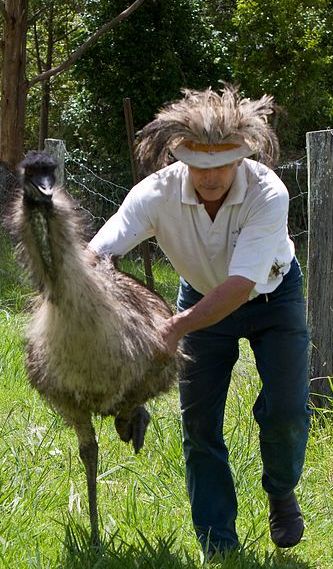 |
|||||||
| Major Activities |
Poultry:: Emu:: Catching and Handling |
||||||
Emus - catching and handling Emus need to be caught and handled for a variety of reasons including:
Expertise in catching and handling takes time to develop. The safety of handlers and emus is a prime concern. Emus up to two months of age (8 kg) are easily restrained and even though their legs at this stage are quite powerful, if the handler is conscious of the potential for injury and wears suitable protective clothing (jeans, overalls, boots etc), little chance of injury is likely. By the age of about seven months the immature bird stands about 2 m high, weighs 18 kg and the feet can be extremely dangerous. Handling adult emus (45+ kg) is considerably harder. Before you attempt to catch emus yourself, it is strongly recommended that:
Once emus are placed inside a darkened shed, similar to those used for handling deer, they quieten down and can be worked far more easily and quietly than they can outside. The problem at present is to devise good techniques for driving emus from their pens into the darkened handling facilities eg emus under six months can be worked successfully with experienced sheep dogs, however older birds cannot. Emus are not an aggressive animal and on all occasions will try to avoid running over handlers.Emus which have had human contact since they were chickens are extremely friendly and inquisitive and will approach stockman without fear. The more time you spend with emus ushering them in and out of gates and down laneways, the easier they are to handle. Even so they are a very difficult animal to drive in a set direction like cattle and the use of mobile barriers in the laneways may help. Talk to other emus farmers about this. Large emus can be restrained more easily by using one of the developed holding methods where the handler catches the bird from behind. Emus tend only to kick forward therefore all handling should occur from behind or at the side. Hold the wings firmly and keep your hands and arms as close to its body as possible to avoid being kicked. Position your feet and lower shins so they are on the outside of the emus feet - the back of the emus leg has a hard, slightly serrated edge which can inflict a painful blow to the shin. The emus do not deliberately try to injure you but will struggle to get loose and can cause injury during these struggles. An alternative method used is to catch the emu then stand behind the animal with one hand across its back providing downward pressure while the other hand is placed from the side around the bird to clutch the soft skin area between the legs and hard bare area of the breast plate. If pressure is applied by squeezing a handful of skin in this area the emu tends to become immobile. An emu may struggle quite strongly when first caught, and another person may be required to take over holding the bird from the catcher if it doesn't settle down within a minute or two. Holding a struggling emu can be hard work. Most tend to settle down within a minute or so with a few exceptions. Once they have settled down after being caught, large birds can be walked through gates, etc. Smaller birds can be picked up and carried in the following manner. Place one arm between the back legs from the rear to meet the other arm coming down from the wing/front of the leg area. Lifting the bird will then place its back against your chest and it can be carried. If, at any stage when catching or handling an emu, you lose your grip or lose control, release the bird immediately and move away as quickly as possible to avoid being kicked.
If you do find yourself in front of a struggling emu and in a potentially dangerous situation, try to seize the bird's upper neck or back of the head, and pull the neck and head forward and downwards. This tends to put the animal off balance, and negates the emu kicking forwards, giving you a little more time to get out of the way. It is important that emu handlers remove watches etc from the wrist area to avoid the emus toes potentially getting hooked in them as well as having some protection for the chest and upper body. If emus are handled correctly it is unlikely that serious injury will occur, although accidents can happen. (Source:http://www.dpi.qld.gov.au/cps/rde/dpi/hs.xsl/27_2750_ENA_HTML.htm ) | |||||||
Technologies |
|||||||
Veterinary Services |
|||||||
| Home | Success Stories | Publication | Gallery | Forms | FAQs | Related Links | Contact | |
|||||||
| © All Rights Reserved. TNAU-2008. |
|||||||
